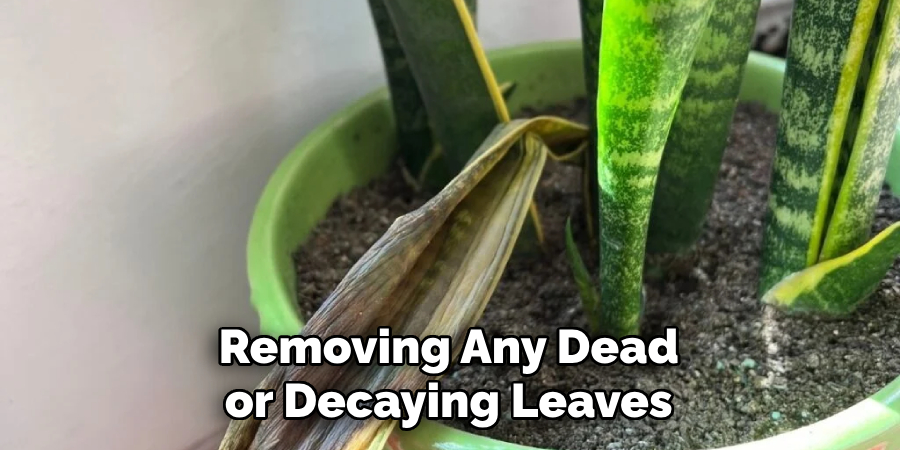To treat fungus on a snake plant, isolate the affected plant and apply a fungicide solution according to the product instructions. Introducing fungus to your beloved snake plant can be disheartening.
Fungus can manifest as unsightly blotches and discoloration on the leaves, hampering the plant’s growth and overall health. However, there is hope! By taking some strategic steps, you can effectively treat the fungus and restore your snake plant’s vitality. This article will guide you through the necessary actions to combat the issue and bring your snake plant back to its former glory.
So, let’s jump right in and explore the methods to fix the fungus problem swiftly and efficiently. Remember to follow the steps carefully, and soon your snake plant will be back to flourishing in no time.

Credit: www.indoorplantsforbeginners.com
Signs And Symptoms Of Fungus On Snake Plant
Fungus on snake plants can manifest through yellowing or browning leaves, leaf spots or patches, discoloration or wilting of stems, and the presence of fuzzy or powdery growth. These signs and symptoms indicate a fungal infection and should be addressed promptly to treat the issue.
To effectively treat fungus on snake plants, it is important to identify the type of fungus and choose the appropriate treatment method. One common way to treat fungus is by removing the affected leaves or portions of the plant and isolating it to prevent further spread.
Using a fungicide can also help eliminate the fungus and promote healthy growth. Additionally, maintaining proper watering and humidity levels can prevent future fungus outbreaks. Proper care and attention will ensure your snake plant remains healthy and free from fungus.
How to Treat Fungus on Snake Plant: Step by Step Guide
Identifying The Type Of Fungus
Fungal infections on snake plants can be identified by understanding the various types. Powdery mildew, leaf spot fungus, and root rot are common culprits. These infections can be differentiated by their distinct symptoms. Environmental factors, such as high humidity and poor drainage, contribute to fungal growth.
Proper identification of the fungus is essential for effective treatment. Regularly inspecting the plant for signs of infection and providing optimal growing conditions will help prevent fungal issues. Maintain good airflow around the plant and avoid overwatering to minimize the risk of fungus.
Additionally, removing any infected leaves or parts can help contain the spread of the infection. By considering these factors and promptly addressing any fungal issues, you can successfully treat fungus on your snake plant.
Natural Remedies For Treating Fungus On Snake Plant
Snake plants are prone to fungus growth, but there are natural remedies to treat this issue. Improving air circulation and reducing humidity can help prevent the growth of fungus. Adjusting watering practices is crucial, as overwatering can contribute to fungus development.
To combat the fungus, you can use neem oil or other natural fungicides as a treatment option. If your snake plant is infected, it’s important to isolate it from other plants to prevent the spread of the fungus. By following these steps, you can effectively treat fungus on your snake plant and ensure its health and vitality.
Repotting And Soil Management
When treating fungus on a snake plant, repotting and soil management are essential steps. One crucial aspect is assessing the health of the current soil and potting mix. By understanding the condition of the soil, you can determine whether it is suitable for the plant’s overall well-being.
To combat the fungal infection, repotting the snake plant is necessary. When choosing a soil mix for repotting, opt for one that is well-draining. This is crucial in preventing future growth of fungus, as excessive moisture can contribute to its development.
By following these steps and paying attention to the soil, you can effectively treat fungus on a snake plant and ensure its long-term health.
Enhancing Plant Health And Preventing Future Fungal Infections
Snake plants are prone to fungal infections, but by providing optimal light and temperature conditions, you can enhance their health and prevent future issues. Regularly inspect and clean the leaves to avoid dust and fungal spore buildup. Proper watering techniques are crucial to prevent excess moisture that can encourage fungal growth.
Avoid overcrowding the plants or placing them near other susceptible ones to minimize the risk of cross-contamination. Remember, prevention is key when it comes to treating fungus on snake plants. By following these guidelines, you can ensure the long-term health and vitality of your snake plant.
So take the necessary precautions and enjoy the beauty of your thriving, fungus-free snake plant.
Professional Treatments And Pest Control
Snake plants are susceptible to fungal infections, but there are effective treatments available. Consulting a professional plant care specialist is recommended for severe or persistent infections. Before resorting to chemical treatments, it is important to exhaust other options. Identifying and managing any accompanying pest infestations is also crucial for successful treatment.
Monitoring And Maintenance For Healthy Snake Plants
Regular inspection is crucial to avoid the reoccurrence of fungus on snake plants. Prevention is key to maintaining their health, so implementing preventive measures is essential. By adjusting care practices, such as limiting moisture and ensuring proper drainage, unfavorable conditions for fungus growth can be created.
This includes not overwatering and regularly removing any dead or decaying leaves. Additionally, providing adequate lighting and ensuring proper air circulation will help prevent fungus from taking hold. Paying attention to the early signs of fungal infection, such as discolored or wilting leaves, can help catch and treat the problem before it spreads.

Overall, being proactive in monitoring and maintaining snake plants will help ensure their long-term health and prevent fungus-related issues.
Frequently Asked Questions For How To Treat Fungus On Snake Plant
How To Identify Fungus On Snake Plants?
To identify fungus on snake plants, look for signs such as yellow or brown spots on the leaves, white or gray powdery patches, or wilting leaves. Proper identification is essential before treating the fungus to ensure effective treatment.
What Causes Fungus On Snake Plants?
Fungus on snake plants is typically caused by overwatering or high humidity levels. These conditions create a favorable environment for fungal growth. Proper watering technique and ensuring adequate airflow can help prevent and control fungus on snake plants.
How To Treat Fungus On Snake Plants?
To treat fungus on snake plants, first, isolate the affected plant to prevent further spread. Trim away any infected leaves and improve airflow around the plant by spacing them adequately. Apply a fungicide specifically formulated for houseplants as recommended, and adjust watering to prevent overhydration.
Can I Use Homemade Remedies To Treat Fungus On Snake Plants?
While some homemade remedies may help control fungus on snake plants, it is best to use commercially available fungicides designed for houseplants. These products are specifically formulated, safe, and effective in combating fungal infections. Homemade remedies may not provide sufficient protection or could potentially harm the plant.
Conclusion
Overall, treating fungus on snake plants requires proper care and attention. By following the right steps, you can effectively get rid of the fungus and ensure the health of your plant. Firstly, identify the signs of fungus, such as yellowing leaves and white powdery patches.
Next, address the root cause of the issue, which could be overwatering, poor airflow, or inadequate lighting. Adjust your watering schedule, provide proper ventilation, and place the plant in a location with sufficient light. Additionally, consider using organic fungicides or natural remedies like neem oil or baking soda to control the fungus.
Regularly inspect your snake plant for any signs of fungus and take immediate action if detected. Remember, prevention is key, so maintain proper plant hygiene and avoid overwatering. With a little care and attention, your snake plant can thrive and remain free from fungus.

